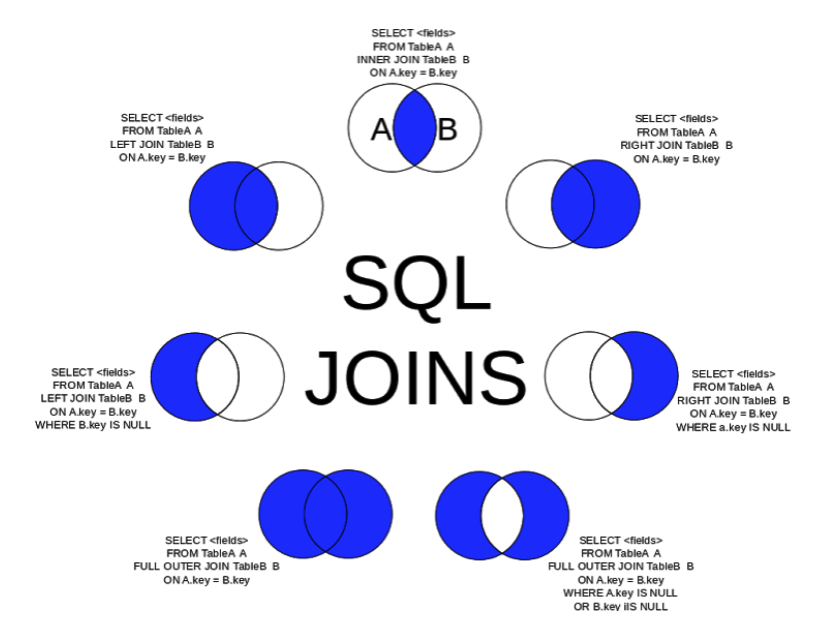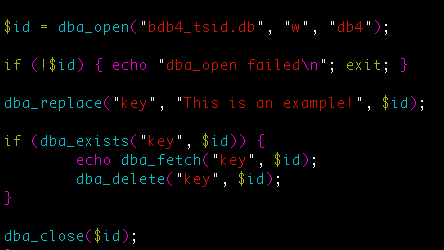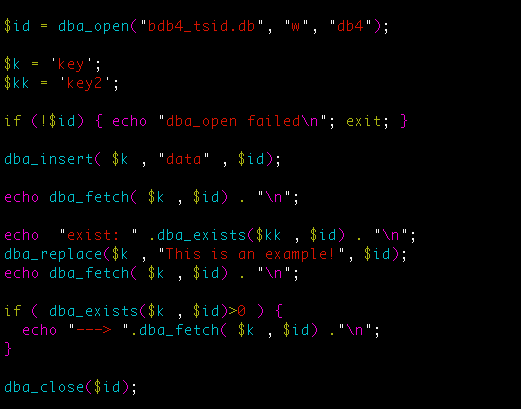
DATABASE
[PHP] Sample code : Berkeley DB , bdb , dba_open , db4 , key-value database ,
$id = dba_open("bdb4_tsid.db", "w", "db4");
if (!$id) { echo "dba_open failed\n"; exit; }
dba_replace("key", "This is an example!", $id);
if (dba_exists("key", $id)) {
echo dba_fetch("key", $id);
dba_delete("key", $id);
}
dba_close($id);


This is an example! exist: This is an example! ---> This is an example!
install oracle 11g steps
記錄一下, 方便查詢
ORACLE URL : Installing Oracle Database 11g Release 1 on Enterprise Linux 5 (32- and 64-bit)
– http://www.oracle.com/technology/pub/articles/smiley-11gr1-install.html?rssid=rss_otn_articles
ORACLE wiki : http://wiki.oracle.com/
step-by-step screenshots : http://www.thegeekstuff.com/2008/10/oracle-11g-step-by-step-installation-guide-with-screenshots/
Install Oracle 11g on CentOS with VMware ( Mac )
– http://wiki.oracle.com/page/Installing+Oracle+11g+on+CentOS+under+VMWare+on+a+Macbook
Oracle 11g R1 Enterprise安裝研究(CentOS 5.2) : http://forum.icst.org.tw/phpbb/viewtopic.php?f=21&t=16411&start=0&sid=866700eee479d130d126967c3160e7f4
Oracle 11g R2 Enterprise (CentOS 5.3 x86_64) 安裝筆記 : http://hans0713.blogspot.com/2009/10/oracle-11g-r2-enterprise-centos-53.html
Oracle 9i Streams 安裝步驟 – http://www.oracle-base.com/articles/9i/Streams9i.php
Oracle 11g Release 2 RAC On Linux Using VMware Server 2 –
http://www.oracle-base.com/articles/11g/OracleDB11gR2RACInstallationOnOEL5UsingVMwareServer2.php
筆記一下網上看到的:
Linux OS 下這些調整 sysctl
fs.file-max = 65535 kernel.shmall = 2097152 kernel.shmmax = 2147483648 kernel.shmmni = 4096 kernel.sem = 250 32000 100 128 net.ipv4.ip_local_port_range = 1024 65535 net.core.rmem_default = 4194304 net.core.rmem_max = 4194304 net.core.wmem_default = 262144 net.core.wmem_max = 262144
Database administrator
A database administrator (DBA) is a person who is responsible for the environmental aspects of a database. The role of a database administrator has changed according to the technology of database management systems (DBMSs) as well as the needs of the owners of the databases. For example, although logical and physical database design are traditionally the duties of a database analyst or database designer, a DBA may be tasked to perform those duties.
Duties
The duties of a database administrator vary and depend on the job description, corporate and Information Technology (IT) policies and the technical features and capabilities of the DBMS being administered. They nearly always include disaster recovery (backups and testing of backups), performance analysis and tuning, data dictionary maintenance, and some database design.
Some of the roles of the DBA may include
- Installation of new software — It is primarily the job of the DBA to install new versions of DBMS software, application software, and other software related to DBMS administration. It is important that the DBA or other IS staff members test this new software before it is moved into a production environment.
- Configuration of hardware and software with the system administrator — In many cases the system software can only be accessed by the system administrator. In this case, the DBA must work closely with the system administrator to perform software installations, and to configure hardware and software so that it functions optimally with the DBMS.
- Security administration — One of the main duties of the DBA is to monitor and administer DBMS security. This involves adding and removing users, administering quotas, auditing, and checking for security problems.
- Data analysis — The DBA will frequently be called on to analyze the data stored in the database and to make recommendations relating to performance and efficiency of that data storage. This might relate to the more effective use of indexes, enabling "Parallel Query" execution, or other DBMS specific features.
- Database design (preliminary) — The DBA is often involved at the preliminary database-design stages. Through the involvement of the DBA, many problems that might occur can be eliminated. The DBA knows the DBMS and system, can point out potential problems, and can help the development team with special performance considerations.
- Data modeling and optimization — By modeling the data, it is possible to optimize the system layouts to take the most advantage of the I/O subsystem.
- Responsible for the administration of existing enterprise databases and the analysis, design, and creation of new databases.
- Data modeling, database optimization, understanding and implementation of schemas, and the ability to interpret and write complex Structured Query Language (SQL) queries
- Proactively monitor systems for optimum performance and capacity constraints
- Establish standards and best practices for SQL
- Interact with and coach developers in SQL scripting
在 gentoo 裝 oracle sqlplus package

去 Oracle 那邊 download 
那個 instantclient-sqlplus-linux32-11.1.0.7.zip
放到 /usr/portage/distfiles
下 emerge -av dev-db/oracle-instantclient-sqlplus